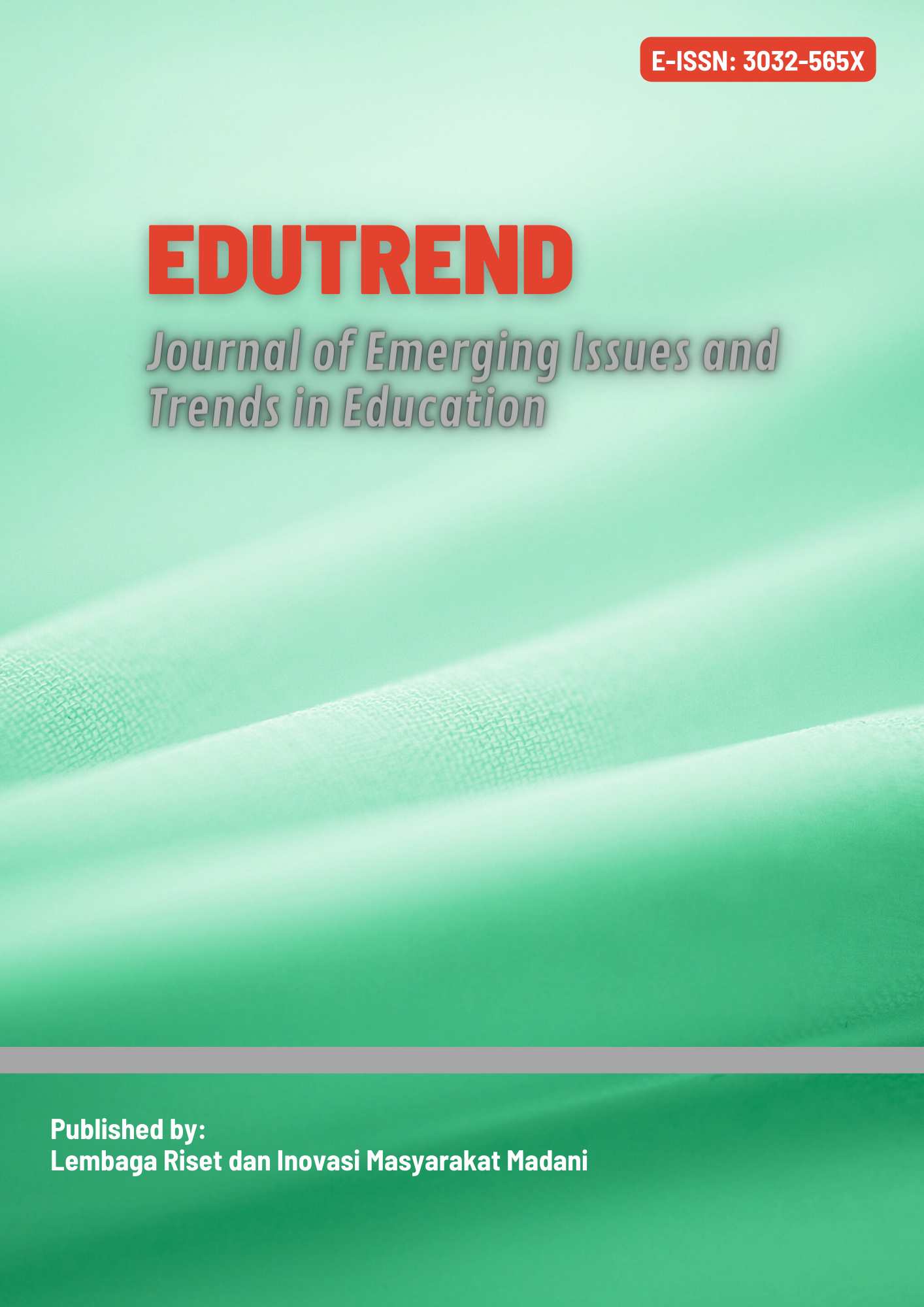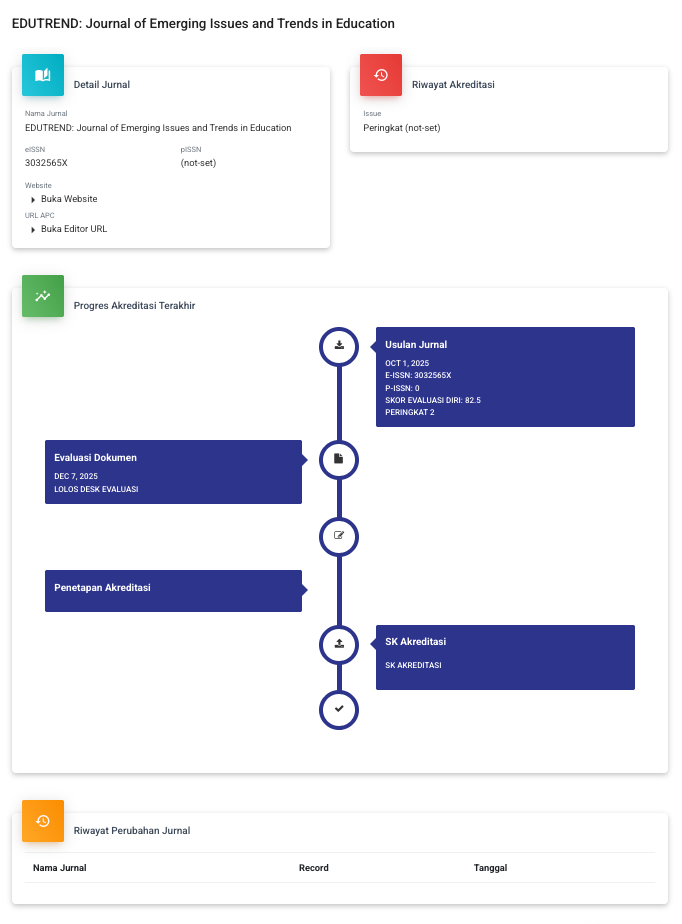Dive into English Phonology: Foundational concepts and teaching strategies for novice EFL learners
DOI:
https://doi.org/10.59110/edutrend.617Keywords:
Articulatory Phonology, Communicative Competence, English Phonology, Learner-Centered Pedagogy, Systematic Literature ReviewAbstract
Mastering English phonology is essential for second language acquisition, as it influences pronunciation accuracy, listening comprehension, and communicative competence. However, beginner English as a Foreign Language (EFL) learners often encounter difficulties due to the complexity of phonological theories and irregular spelling-to-sound correspondences. This study presents a systematic literature review, guided by the PRISMA framework, to examine key challenges and effective teaching strategies in English phonology instruction for beginners. A comprehensive search of Google Scholar and CrossRef databases identified 1,037 records published between 2019 and 2024. After screening and quality appraisal, 25 high-quality studies were included in the synthesis. Findings indicate that articulatory phonology, though theoretically robust, is impractical for classroom application due to its dependence on computational models and language-specific data. Additionally, inconsistencies between English spelling and pronunciation frequently lead to learner errors and reduced confidence. While students improve in recognizing phonetic symbols, current instructional methods often lack interactive, practice-based approaches. The review highlights the need to simplify complex phonological concepts and adopt learner-centered, communicative pedagogies. These insights offer valuable guidance for enhancing phonological competence and communicative effectiveness among novice EFL learners, addressing an important gap in current phonology instruction literature.
References
Abreu, P., & Gathercole, S. (2012). Executive and phonological processes in second-language acquisition. Journal of Educational Psychology, 104(4), 974–986. https://doi.org/10.1037/a0028390
Ali, A., Ahmadi, N., Aziz, A., & Munandar, L. (2023). The use of local language constraint-based in the pronunciation of standard English: A study at Sasaknese learners of West Nusa Tenggara. Journal of English Education Forum (Jeef), 3(2), 35–39. https://doi.org/10.29303/jeef.v3i2.575
Alzahrani, A., & Algethami, G. (2023). Phonological awareness and word reading fluency among young Saudi learners of English. International Journal of Language and Literary Studies, 5(1), 14–27. https://doi.org/10.36892/ijlls.v5i1.1183
Ambalegin, A., & Arianto, T. (2019). A phonology-based study: English pronunciation inconsistency. In The 2nd Annual International Conference on Language and Literature (AICLL 2019) (pp. 106–124). Medan, Indonesia: KnE Social Sciences. https://doi.org/10.18502/kss.v3i19.4834
Arafiq, A., Ahmadi, N., Aziz, A., & Munandar, L. (2023). The use of local language constraint-based in the pronunciation of standard English: A study at Sasaknese learners of West Nusa Tenggara. Journal of English Education Forum (Jeef), 3(2), 35–39. https://doi.org/10.29303/jeef.v3i2.575
Bdaiwi, S., & Sayer, I. (2023). Evaluating the communicative competence of EFL students in Iraqi universities. Koya University Journal of Humanities and Social Sciences, 6(1), 185–196. https://doi.org/10.14500/kujhss.v6n1y2023
Belaidouni, D., Simerabet, M., & Yahiaoui, A. (2024). Classroom discourse in negotiating meaning via cross-linguistic-cultural interferences. International Journal of Research and Innovation in Social Science. https://doi.org/10.47772/ijriss.2023.7012119
Burri, M. (2023). Comparing L2 teachers’ practices with learners’ perceptions of English pronunciation teaching. Profile: Issues in Teachers' Professional Development, 25(1). https://doi.org/10.15446/profile.v25n1.101156
Cadime, I., Alves, D., Mendes, S., Pinto, P., & Cruz, J. (2024). Teachers’ beliefs and practices to support emergent literacy development in preschool education: The moderating role of continuous training. International Journal of Early Childhood, 57(1), 157–179. https://doi.org/10.1007/s13158-024-00393-2
Espinoza, M., Cárdenas, Y., Martinez, C., & Saavedra, F. (2021). The use of audiovisual materials to teach pronunciation in the ESL/EFL classroom. South Florida Journal of Development, 2(5), 7345–7358. https://doi.org/10.46932/sfjdv2n5-074
Febian, C., Mabrurah, F., Affara, F., Nazulfa, L., & Agustiningsih, T. (2022). English phonology: Student’s perception toward English sound application to the learning of pronunciation. Conference on English Language Teaching. https://doi.org/10.24090/celti.v2.52
Gilakjani, A. (2017). English pronunciation instruction: Views and recommendations. Journal of Language Teaching and Research, 8(6), 1249–1256. https://doi.org/10.17507/jltr.0806.30
Haile, S., & Mendisu, B. (2023). Early-grade reading: The challenges that affect teachers’ practice of phonological awareness: The case of Koorete language. Education Research International, 2023, Article 9527369. https://doi.org/10.1155/2023/9527369
Hung, M. (2024). Vietnamese English-major students’ views and practices on English pronunciation. Dong Thap University Journal of Science, 13(7), 35–45. https://doi.org/10.52714/dthu.13.7.2024.1336
Jahara, S., & Abdelrady, A. (2021). Pronunciation problems encountered by EFL learners: An empirical study. Arab World English Journal, 12(4). https://doi.org/10.24093/awej/vol12no4.14
Kadhim, B. J., & Mohammed, A. A. M. (2022). A critical account of articulatory phonology: A subject review. Bulletin of Advanced English Studies, 7(1), 7–10. https://doi.org/10.31559/BAES2022.7.1.2
Karlin, R. (2020). Expanding the gestural model of lexical tone: Evidence from two dialects of Serbian. https://doi.org/10.31234/osf.io/ztf9a
Lei, T., & Trung, N. (2024). Discovering English pronunciation difficulties and strategies: A case at Tra Vinh University. European Journal of Foreign Language Teaching. https://doi.org/10.46827/ejfl.v8i2.5401
Low, E. (2021). EIL pronunciation research and practice: Issues, challenges, and future directions. RELC Journal, 52(1), 22–34. https://doi.org/10.1177/003368822098731
Lu, X. (2023). Phonological awareness (PA) in Chinese-English bilingual word decoding (reading). Journal of Education Humanities and Social Sciences, 20, 293–297. https://doi.org/10.54097/ehss.v20i.11685
Marelita, D., & Iftanti, E. (2024). Exploring factors influencing phonological errors of Indonesian EFL students. Journal of English Language Teaching and Learning (JETLE). https://doi.org/10.18860/jetle.v6i1.27060
Mayadah, M., Dj., M., & Nur, H. (2024). The effect of suprasegmental pronunciation on speaking skills of Buginese EFL learners. International Journal of Research on English Teaching and Applied Linguistics. https://doi.org/10.30863/ijretal.v5i1.6753
Mücke, D., Hermes, A., & Tilsen, S. (2020). Incongruencies between phonological theory and phonetic measurement. Phonology, 37, 133–170. https://doi.org/10.1017/S0952675720000068
Nguyen, L., & Hung, B. (2021). Communicative pronunciation teaching: Insights from the Vietnamese tertiary EFL classroom. System, 101, 102573. https://doi.org/10.1016/J.SYSTEM.2021.102573
Nwokedi, B. (2023). Efficacy of the use of audio-visual facilities in the teaching and learning of English phonology. International Journal of Arts, Social Sciences and Education, 1(4), 183–190. https://doi.org/10.59890/ijasse.v1i4.733
Prabhu, M., Shwetha, P., & Somashekara, H. (2023). Phonological awareness and alphabetic knowledge in typically developing English language learners between the 3.6 to 6.6 years. Reading Psychology, 45, 242–260. https://doi.org/10.1080/02702711.2023.2276463
Prahaladaiah, D., & Thomas, K. (2024). Effect of phonological and phonetic interventions on proficiency in English pronunciation and oral reading. Education Research International, 2024, 1–18. https://doi.org/10.1155/2024/9087087
Putra, R. (2023). Deciphering English vowel digraphs. Pulchra Lingua: A Journal of Language Study, Literature & Linguistics, 2(2). https://doi.org/10.58989/plj.v2i2.26
Ramoo, D., Olson, A., & Romani, C. (2021). Repeated attempts, phonetic errors, and syllabifications in a case study: Evidence of impaired transfer from phonology to articulatory planning. Aphasiology, 35(4), 485–517. https://doi.org/10.1080/02687038.2021.1881349
Saito, K. (2021). What characterizes comprehensible and native‐like pronunciation among English‐as‐a‐second‐language speakers? Meta‐analyses of phonological, rater, and instructional factors. TESOL Quarterly. https://doi.org/10.1002/tesq.3027
Seidlhofer, B. (2015). English as a lingua franca and multilingualism. In The International Encyclopedia of the Social and Behavioral Sciences (pp. 391–404). https://doi.org/10.1007/978-3-319-02325-0_22-1
Shaojie, T., Samad, A., & Ismail, L. (2022). Systematic literature review on audio-visual multimodal input in listening comprehension. Frontiers in Psychology, 13. https://doi.org/10.3389/fpsyg.2022.980133
Tandazo, A., Schatz, T., Hueber, T., & Dupoux, E. (2024). Simulating articulatory trajectories with phonological feature interpolation. ArXiv, abs/2408.04363. https://doi.org/10.48550/arXiv.2408.04363
Tupamahu, M., & Gaspersz, S. (2024). Analysis of EFL students’ difficulties in learning English phonology and phonetics at English Department, Victory University of Sorong. INTERACTION: Jurnal Pendidikan Bahasa. https://doi.org/10.36232/interactionjournal.v11i2.39
Utami, I., & Lintangsari, A. (2021). English phonology for language learners: Exploring learners’ preferences. International Journal of Humanity Studies (IJHS). https://doi.org/10.24071/IJHS.V4I2.3234
Vassoler, A., & Berti, L. (2018). Padrões silábicos no desenvolvimento fonológico típico e atípico: Análise ultrassonográfica. Codas, 30(2). https://doi.org/10.1590/2317-1782/20182017067
Wahib, M., & Tamer, Y. (2021). Exploring the effect of the flipped classroom model on EFL phonology students’ academic achievement. International Journal of Language and Literary Studies, 3(2), 37–53. https://doi.org/10.36892/ijlls.v3i2.581
Yi, W. (2023). The influence of Shandong dialect on English learning. Communications in Humanities Research, 10(1), 93–98. https://doi.org/10.54254/2753-7064/10/20231262
Yolanda, A. (2019). Unlocking learners’ difficulties in acquiring English consonant sounds ([ð] and [θ]) and the implication for teaching. https://doi.org/10.2991/conaplin-18.2019.289
Yüksel, D., Soruç, A., & McKinley, J. (2021). The relationship between university EFL teachers’ oral feedback beliefs and practices and the impact of individual differences. International Review of Applied Linguistics in Language Teaching. Advance online publication. https://doi.org/10.1515/iral-2021.0051
Downloads
Published
How to Cite
Issue
Section
License
Copyright (c) 2025 Susy Deliani, Alexander Yandra, Kurniawan, Angelin Yuliana

This work is licensed under a Creative Commons Attribution-ShareAlike 4.0 International License.















 the Creative Commons Attribution-ShareAlike 4.0 International License |
the Creative Commons Attribution-ShareAlike 4.0 International License | 